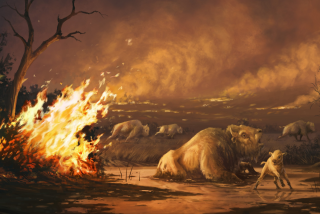Workers Unearth Mastodon Remains at Construction Site
Workers digging home sites in Simi Valley have uncovered the skeletal remains of a prehistoric mastodon that scientists are calling a major discovery in California paleontology.
The skull, tusks, jaws, teeth and femur of the long-extinct mammal were found two weeks ago at the bottom of a 30-foot pit dug by workers building the 800-home Big Sky Ranch project. The mastodon, which is related to the modern-day elephant, will be shipped to the Los Angeles County Museum of Natural History today for further study and a possible exhibit.
“Maybe we have a whole Jurassic Park out here,” said Mike Mayfield, superintendent of the construction site, as he looked at a giant tusk on a flatbed truck. “We have hit Indian skeletons. We hit a walrus skeleton in Newbury Park, but this is the first mastodon” uncovered by the company.
Scientists say that unlike their cousin, the woolly mammoth, only a handful of the smaller mastodons have been unearthed in California. Many more have been found in the Midwest and on the East Coast.
The Simi Valley mastodon is estimated to weigh more than one ton and be up to 30,000 years old. Its tusks alone are several hundred pounds each, and its dozen 2-inch-long teeth are conical, unlike the flatter grazing teeth of modern elephants.
“It’s quite a big deal. Only a few mastodons have ever been found in this area,” said Cara Corsetti, project manager for paleontology at SWCA Environmental Consultants in Mission Viejo, which sent scientists to the Simi Valley site to excavate the mastodon. “We find a lot of marine mammals in this area--whales, sea lions, seals, walruses, early representatives of the sea cow group, but no mastodons.”
A huge mastodon was found in 1997 near Hemet during construction of a dam in Riverside County.
While mastodon skeletons are rare, pygmy mammoth remains have been found on the Channel Islands. Scientists believe there was once either a land bridge to the islands or that the animals swam there. Mastodons appeared 3.75 million years ago and became extinct about 11,000 years ago. Scientists believe they were powerfully built, covered in reddish hair and were up to 10 feet tall and 15 feet long--shorter but longer than modern elephants.
The Simi Valley discovery was made when a construction team was digging a pit in one of the green hillsides off Erringer Road.
Julia Frazier, a paleo-monitor hired to look out for bones and fossils, was scrambling between 15 large ground scrapers as they took off layers of dirt when she spotted something sticking up from the ground. Work halted as she dug in the silt.
“I saw what I think was part of the scapula [shoulder],” she said. “It was literally just an inch out of the ground. I started picking away at it with an ice pick, and a whole row of teeth began to emerge. I saw these molars that were 5 inches across. I said, ‘Please, don’t be a cow.’ ”
Eventually, tusks and leg bones emerged. After more than a week, the skeletal remains were extracted from the ground. They have all been packed for shipping.
“I was pretty excited because I was used to just finding shells and small rib bones,” Frazier said. “But to find a jaw fully intact and [for it] to be from a mastodon was amazing.”
Scott Armstrong, a paleontologist from SWCA who supervised the dig, said the mastodon was probably walking along the hillside when it died. It was later covered by an ancient landslide and buried beneath 30 feet of alluvial silt. Its precise age, now estimated at 30,000 years because of the age of the soil it was found in, will be determined by experts at the museum.
“Even though some of these animals are common in our knowledge, in terms of numbers of specimens there aren’t many,” said John Heyning, deputy director for research and collections at the Los Angeles County Museum of Natural History. “Each additional specimen provides us with more insight into their lives. This really speaks to how much the landscape of Southern California changed. Twenty thousand years ago we had saber-toothed cats, mastodons and pygmy mammoths on the Channel Islands.”
Heyning said the museum has mastodon remains in its George C. Page Museum at the La Brea Tar Pits.
Armstrong said mastodons had many of the same social habits as elephants and that they traveled in herds. But unlike elephants, there is no evidence that mastodons had burial grounds where they all went to die, he said. Still, Armstrong said he thinks there could be more discoveries at the site. The soil may be 30,000 years old, a mere blip in geological time, but the bedrock beneath it is 30 million years old.
“There is a chance we could find more animals in that area,” he said.
During his career in construction, Mayfield said he has found Chumash artifacts and pottery, which were returned to the tribe. He even found a Ford Model T buried in Thousand Oaks.
But the mastodon stunned him. “I brought my kids down here to see it,” he said, looking at the deep pit where the bones were found. “It was very exciting to see the thing there all in one piece.”
More to Read
Sign up for Essential California
The most important California stories and recommendations in your inbox every morning.
You may occasionally receive promotional content from the Los Angeles Times.










